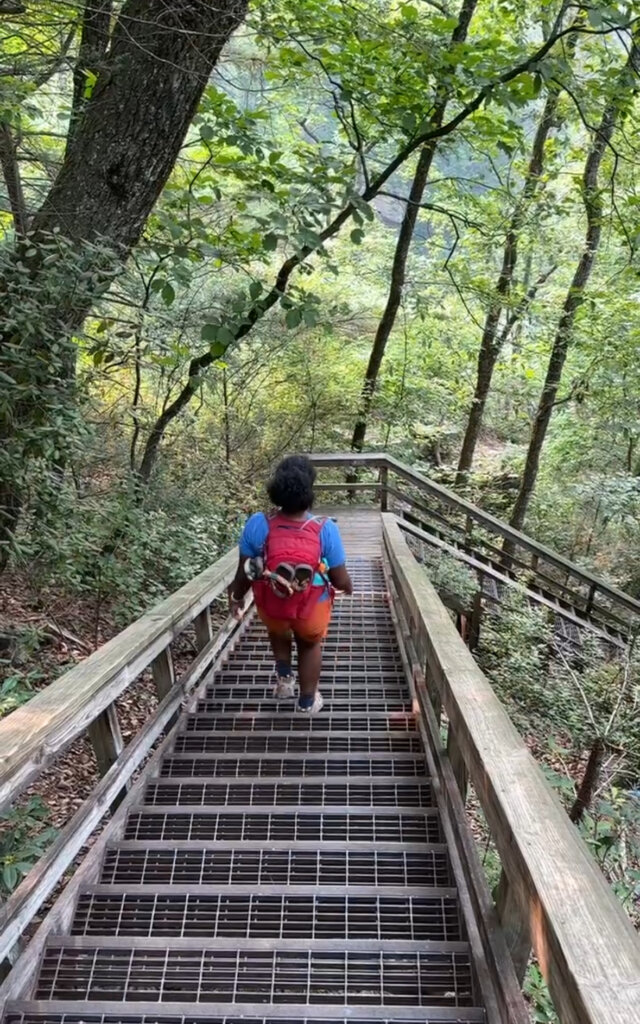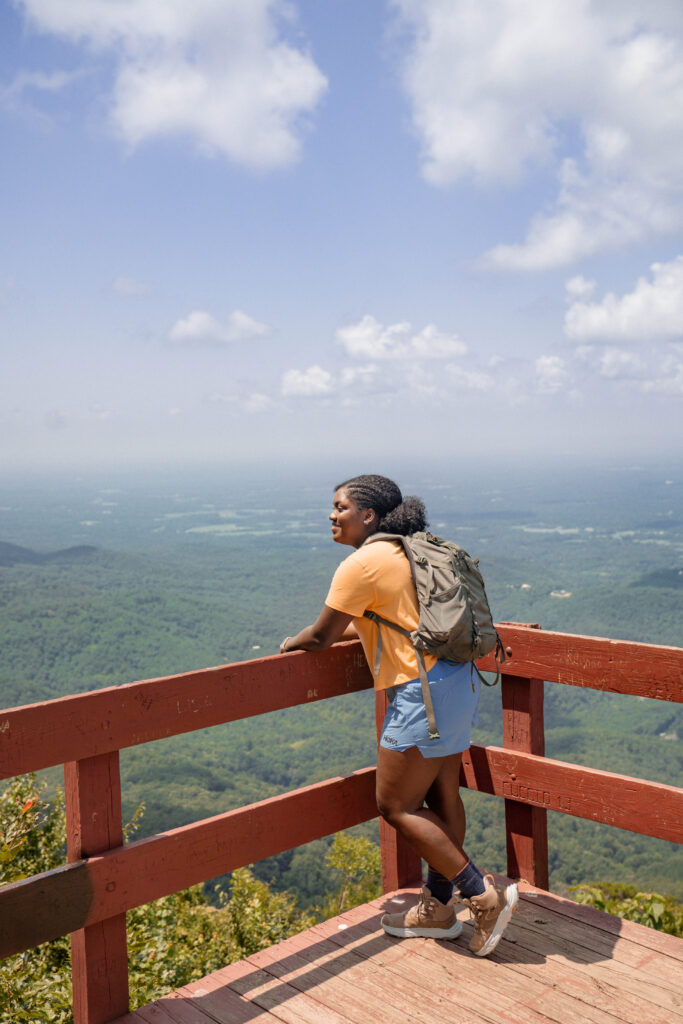There’s something incredible about stepping onto a trail, whether it’s for your first time ever, your escape to the scent of truly fresh air, or the way your thoughts start to quiet as the forest surrounds you. For many of us, hiking isn’t just a workout; it’s a way to unplug, reconnect, and find clarity in the chaos of everyday life—and it all starts with knowing the essentials for hiking.
But as the trails become more popular (which, let’s be real, we love to see!), it’s more important than ever that we move through these spaces with intention. Whether you’re hiking solo, bringing friends along, or venturing out with your dog, remembering a few simple trail etiquette guidelines helps protect the land, keeps wildlife safe, and ensures that everyone can enjoy the peace that nature offers.
So before you lace up your boots and head out, let’s walk through some essentials for hiking—some easy do’s and don’ts that’ll help you be a more mindful hiker. Because sharing the trail isn’t just about making space—it’s about respect, community, and love for the outdoors. And knowing the essentials for hiking will set you up for safer, more enjoyable adventures every time.
ALSO READ: Best Hikes in Georgia
✅ Do’s
When it comes to being a good trail companion, a little courtesy goes a long way. These simple habits help create a positive experience for everyone. These are the things you should be doing on the trail, and will help you not just be polite, but stay safe and make the outdoors more welcoming for all. Keeping these essentials for hiking in mind makes every experience smoother—for you and everyone around you.
Yield to Uphill Hikers


One of the golden rules of hiking, but something that’s often overlooked, is knowing when to yield. A general rule of thumb is that hikers going uphill have the right of way. It might not seem like a big deal, but when you’re climbing, every step takes effort and rhythm. Stopping mid-climb can throw off your momentum, especially on steep or narrow trails.
If you’re heading downhill and notice someone approaching from below, take a quick pause and step aside safely to let them pass. Not only is this considered respectful trail etiquette, but it also helps prevent congestion and allows everyone to enjoy their hike without added stress. A friendly smile or “you got this!” never hurts either — it helps create a positive trail environment. This is one of those small essentials for hiking that makes a big difference.
Of course, use your judgment. Sometimes uphill hikers might wave you through, especially if they’re taking a break. But as a default, be the one to yield when descending. It’s a small gesture that makes a big difference, and keeps the trail feeling welcoming and courteous for all.
Let Faster Hikers Pass
We all hike at different paces—and that’s the beauty of it. Some folks are out there to push their limits, while others are there to soak up the scenery. Regardless of which you fall under, one of the kindest things you can do on the trail is be aware of your surroundings and step aside if someone behind you is moving faster.
Letting quicker hikers pass helps keep the flow of the trail moving smoothly. If you hear footsteps behind you or notice someone consistently gaining on you, find a safe spot to step off to the side, let them by, and then continue at your pace. A quick “go ahead!” or “have a good one!” adds a friendly touch and reminds everyone that the outdoors is a shared space. This is one of those practical essentials for hiking that helps everyone have a better experience.
And if you’re the faster hiker coming up behind someone, be patient. A gentle “on your left” or “whenever you’re ready” goes a long way in making others feel comfortable. At the end of the day, we’re all out there for the same reason—to enjoy nature—and a little trail courtesy helps everyone have a better time.
Use Headphones for Music
Nature has its own soundtrack—birds chirping, leaves rustling, water flowing—and part of the magic of being outdoors is getting to experience that peaceful soundscape uninterrupted. While it’s totally understandable to want a little motivation during a hike (we all love a good playlist), it’s best to keep your music to yourself by using headphones.
Blasting music out loud on the trail can take away from the experience for others, especially those who came out to enjoy the quiet or spot wildlife. Animals are also easily startled by loud, unfamiliar sounds, and music can disrupt their natural behavior or cause them to retreat from the area.
I know that when hiking alone in bear country some people say that you should hike with some kind of noise to ensure you don’t startle a bear or other dangerous predators. In this case a little music can be understandable, but again, think about others on the trail. Don’t have the volume on max and consider turning the volume down when approaching other hikers.
When in doubt, opt for one earbud or keep the volume low so you can still hear what’s happening around you. Plus, there’s something really grounding about walking in silence, hearing only the rhythm of your steps and the sounds of the wild. Let the forest be the DJ! And remember, protecting the natural soundscape is one of the quiet essentials for hiking.
Follow Leave No Trace Principles


When we step into nature, we’re entering someone else’s home—whether that’s a black bear’s backyard or a family of chipmunks scurrying under the leaves. One of the most important ways to show respect is by following Leave No Trace principles: pack out all trash, stick to the trail, and give wildlife space. These small habits help protect the environment so it can be enjoyed for generations to come. Practicing Leave No Trace is one of the non-negotiable essentials for hiking responsibly.
Even things like fruit peels, snack crumbs, or biodegradable items should go home with you. If it wasn’t part of the trail when you arrived, it shouldn’t be left behind. Straying off marked paths might seem harmless, but it can damage fragile plant life, cause erosion, or disrupt animal habitats—especially in popular areas. The trail exists for a reason, and following it helps preserve the land we love. These small decisions are part of the everyday essentials for hiking with intention.
And as tempting as it may be, don’t feed or approach wildlife. Watching animals in their natural habitat is amazing, but keeping a respectful distance ensures their safety and yours. When we all do our part to leave things better than we found them, it creates a culture of care and responsibility that benefits every hiker, critter, and tree out there.
Greet Fellow Hikers


One of the easiest ways to make the outdoors feel more welcoming? A quick smile, wave, or “hey y’all” as you pass someone on the trail. It might seem small, but those little gestures go a long way in creating a sense of community—especially for folks who are new to hiking or might not always feel like they belong in outdoor spaces.
A friendly hello can instantly shift the energy of the trail. It reminds people that we’re all out here for the same reasons: to unplug, breathe, move our bodies, and connect with nature. Plus, it helps build trust among hikers—which can come in handy if someone needs help or directions later on. Building community is one of the heart-led essentials for hiking that keeps people coming back.
So even if you’re zoned into your hike or just enjoying the peace and quiet, don’t be afraid to look up, make eye contact, and offer a quick greeting. You never know whose day you might brighten—or who you’ll inspire to come back to the trail again.
Be Prepared
Being prepared is one of the best ways to ensure a safe and enjoyable hike—especially if you’re exploring a new trail or heading out for more than a couple of miles. Even if the hike seems easy or short, things can change quickly outdoors. That’s why it’s always smart to pack a few basics: water, snacks, and some form of navigation. These are the most practical essentials for hiking you’ll rely on every single time.
Hydration is key, especially in warmer weather or on longer hikes. Bring more water than you think you’ll need, and if it’s a remote trail, consider packing a water filter or purification tablets just in case. Lightweight, energy-boosting snacks like trail mix, fruit, or granola bars are great to have on hand—and can make a big difference if your hike takes longer than expected.
Don’t forget to download a map or screenshot the route before you lose service (because we all know signal is a gamble in the woods). A compass or GPS device can also be a lifesaver on more rugged trails. The goal isn’t to overpack—it’s to be smart, stay safe, and make sure you’re set up to enjoy your adventure without unnecessary stress. Knowing what gear counts as the real essentials for hiking will save you from a lot of headaches.
ALSO READ: What To Pack When Hiking
❌ Don’ts
Don’t Litter
Let’s be real—nothing ruins a beautiful trail quicker than finding snack wrappers, beer cans, bottle caps, or used tissues along the way. One of the easiest (and most important) essentials for hiking is packing out everything you bring in. That means all trash, no matter how small or “natural” it may seem. Yes, even that banana peel or orange rind needs to go in your bag.
Even biodegradable items can take months to break down and can harm wildlife in the meantime. Animals may try to eat things they shouldn’t, or the scent of food waste can encourage them to frequent high-traffic areas, which isn’t safe for them—or for us. Bringing a small trash bag or zip-top bag is one of the easiest essentials for hiking prep and a simple way to make sure you leave no trace.
Think of it like this: the goal is to leave the trail looking like you were never there. When everyone does their part to clean up after themselves, it keeps the outdoors beautiful, protects the ecosystem, and ensures these spaces stay open and enjoyable for future hikers. Small habits, big impact—and definitely one of the non-negotiable essentials for hiking mindfully.
Don’t Disturb Wildlife
One of the coolest parts about being outdoors is getting to witness wildlife in its natural habitat. Whether it’s spotting deer grazing in the distance or watching a squirrel dart across the trail, those moments are part of what makes hiking so special. But as exciting as it is, it’s important to remember that we’re visitors in their home—and we need to respect their space. This kind of awareness is one of the often-overlooked essentials for hiking that makes a lasting difference.
Getting too close, making loud noises, or trying to feed animals can stress them out or even put them in danger. It might feel harmless to toss a snack their way or sneak in for a closer photo, but it can actually change their behavior in ways that aren’t healthy. Wild animals need to stay wild—for their safety and ours. Feeding them, even with the best intentions, can make them dependent on humans and lead to unsafe encounters down the line.
The best way to appreciate wildlife is from a distance. Keep your voice low, observe with curiosity, and let them go about their day undisturbed. When we give animals the space they deserve, it helps protect them and keeps the outdoor experience peaceful for everyone else enjoying the trail. Respecting wildlife is one of the quiet but crucial essentials for hiking in any natural space.
Don’t Hog the Trail
The trail is a shared space, which means being mindful of how much room you’re taking up—especially if you’re hiking in a group. It’s easy to get caught up in conversation or the beauty of the surroundings, but walking side-by-side in a large line can block others from passing and slow down the flow of the trail.
If you notice someone approaching from behind or coming toward you, the polite thing to do is fall into a single file line and make space. This is especially important on narrow trails, steep sections, or popular routes where the path gets crowded. Trail courtesy is one of the social essentials for hiking that keeps the experience enjoyable for everyone.
Hiking is about community just as much as it is about solitude. Being courteous and sharing the trail with intention helps create a more welcoming environment for all hikers—whether they’re speedy thru-hikers or folks out for a slow, scenic stroll. Practicing this mindset is one of the low-effort, high-impact essentials for hiking in groups.
Don’t Leave Markings
It might be tempting to carve your initials into a tree or stack rocks to mark your spot, but leaving markings behind on the trail causes more harm than you might think. Nature is beautiful as it is—and it doesn’t need our signatures or symbols to feel meaningful. In fact, altering natural spaces can damage fragile ecosystems and even confuse other hikers.
Carving into trees or rocks can harm plant life, disrupt wildlife habitats, and go against Leave No Trace principles. Even something as seemingly harmless as building a rock cairn (a stack of stones) can mislead hikers who rely on official trail markers and disturb habitats for insects and small animals that live under rocks. Avoiding these kinds of disruptions is one of the often-forgotten essentials for hiking respectfully.
If you want to remember your hike, take a photo, write about it later, or leave a memory in your heart—not on the landscape. Part of being a respectful hiker is recognizing that we don’t need to leave a trace to make a trail meaningful. Let nature stay wild, untouched, and ready to inspire the next person who walks by. Preserving the integrity of wild spaces is one of the core essentials for hiking with care.
Don’t Ignore Trail Signs
Trail signs are there for a reason—even if they seem easy to overlook. Whether it’s a simple “no trespassing” notice, a trail closure due to weather, or a warning about wildlife activity, these signs help keep you safe and protect the environment. Ignoring them might not seem like a big deal in the moment, but it can lead to dangerous situations or cause lasting damage to the land.
Sometimes a trail is closed to give nature time to recover, prevent erosion, or protect wildlife during sensitive seasons. Other times, it’s about your safety—like avoiding a washed-out bridge or unstable ground. Skipping past a sign or taking a “short cut” might feel adventurous, but it puts you and the trail at risk.
Part of being a responsible hiker is respecting the guidelines that keep the outdoors safe, sustainable, and enjoyable for everyone. So if you see a sign, take a second to read it. Your adventure will still be there—and it’ll be even better knowing you did your part to protect the places we love. Paying attention to signs and rules is one of the easiest and most important essentials for hiking wisely.

